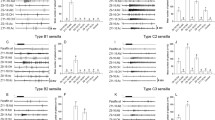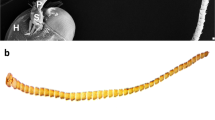Abstract.
The intracellular messenger cGMP (cyclic guanosine monophosphate) has been suggested to play a role in olfactory transduction in both invertebrates and vertebrates, but its cellular location within the olfactory system has remained elusive. We used cGMP immunocytochemistry to determine which antennal cells of the hawkmoth Manduca sexta are cGMP immunoreactive in the absence of pheromone. We then tested which antennal cells increase cGMP levels in response to nitric oxide (NO) and to long pheromonal stimuli, which the male encounters close to a calling female moth. In addition, we used in situ hybridization to determine which antennal cells express NO-sensitive soluble guanylyl cyclase. In response to long pheromonal stimuli with NO donors present, cGMP concentrations change in at least a subpopulation of pheromone-sensitive olfactory receptor neurons. These changes in cGMP concentrations in pheromone-dependent olfactory receptor neurons cannot be mimicked by the addition of NO donors in the absence of pheromone. NO stimulates sensilla chaetica type I and II, but not pheromone-sensitive trichoid sensilla, to high levels of cGMP accumulation as detected by immunocytochemistry. In situ hybridizations show that sensilla chaetica, but not sensilla trichodea, express detectable levels of mRNA coding for soluble guanylyl cyclase. These results suggest that intracellular rises in cGMP concentrations play a role in information processing in a subpopulation of pheromone-sensitive sensilla in Manduca sexta antennae, mediated by an NO-sensitive mechanism, but not an NO-dependent soluble guanylyl cyclase.
Similar content being viewed by others
Author information
Authors and Affiliations
Additional information
Electronic Publication
Rights and permissions
About this article
Cite this article
Stengl, M., Zintl, R., De Vente, J. et al. Localization of cGMP immunoreactivity and of soluble guanylyl cyclase in antennal sensilla of the hawkmoth Manduca sexta . Cell Tissue Res 304, 409–421 (2001). https://doi.org/10.1007/s004410000336
Received:
Accepted:
Issue Date:
DOI: https://doi.org/10.1007/s004410000336




